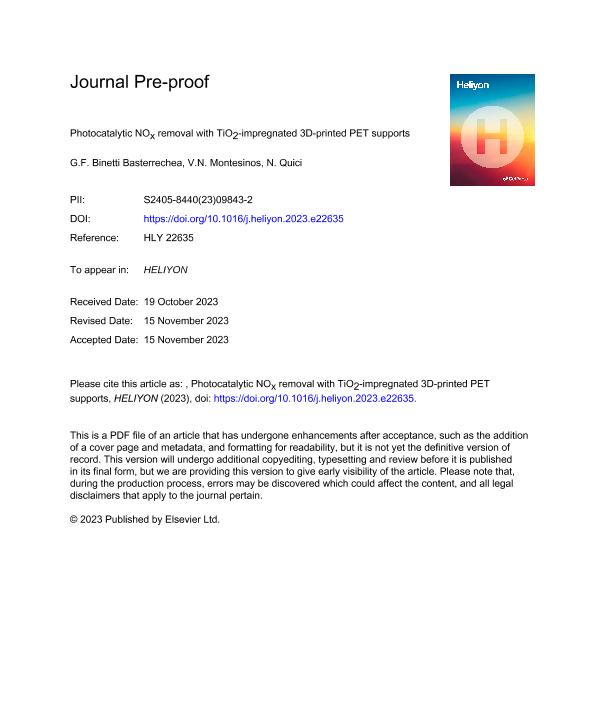Artículo
Photocatalytic NOx removal with TiO2-impregnated 3D-printed PET supports
Fecha de publicación:
11/2023
Editorial:
Elsevier
Revista:
Heliyon
ISSN:
2405-8440
Idioma:
Inglés
Tipo de recurso:
Artículo publicado
Clasificación temática:
Resumen
In this work, we investigated the photocatalytic removal of NOx using 3D-printed supports. Monolithic supports withinternal channels were fabricated by Fused Modelling Deposition (FDM) using PET as the filament feedstock. Theprinting parameters of the supports were optimized to maximize the exposure of the photocatalyst to UV lightthroughout the monolithic PET printed supports. The removal experiments were carried out in a continuous gasphase flow reactor, which was custom designed in-house incorporating a 3D printed PET support impregnated withTiO2 as photocatalyst. The impregnated and non-impregnated supports were characterized by diffuse reflectancespectrometry, SEM and AFM. The effect of several key-factors on the NOX removal capacity was investigated,including the type of PET filament (native recycled, BPET vs. glycol-modified, PETG), the type of TiO2 (P25 vs HombikatUV-100), the UV light source (LED vs. tubular lamps), and the number of deposited TiO2 layers. The highest NO andNOx removal were achieved by using PETG supports coated with a single layer of Hombikat UV-100 and irradiatingthe flat reactor from both sides using two sets of black light lamps. However, the highest selectivity toward nitrateformation was obtained when using P25 under the same experimental conditions. This work demonstrates that 3Dprinting is a reliable and powerful technique for fabricating photocatalytic reactive supports that can serve as aversatile platform for evaluating photocatalytic performance.
Palabras clave:
3D PRINTING
,
PET
,
PHOTOCATALYSIS
,
NOX
Archivos asociados
Licencia
Identificadores
Colecciones
Articulos(SEDE CENTRAL)
Articulos de SEDE CENTRAL
Articulos de SEDE CENTRAL
Citación
Binetti Basterrechea, G. F.; Montesinos, Victor Nahuel; Quici, Natalia; Photocatalytic NOx removal with TiO2-impregnated 3D-printed PET supports; Elsevier; Heliyon; 9; 11-2023; 1-28
Compartir
Altmétricas




